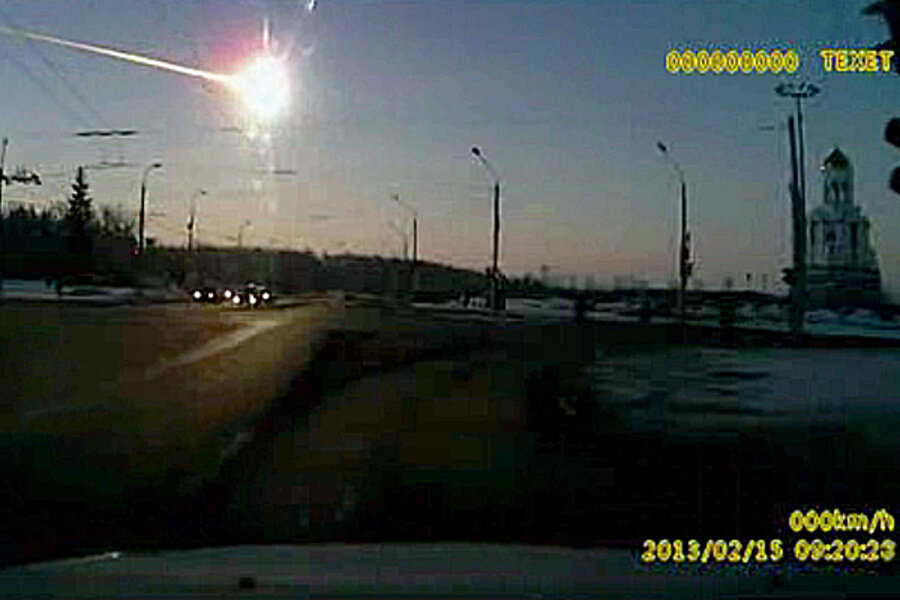Little telescope to hunt big game: hard-to-see near-Earth asteroids
Loading...
Efforts to discover near-Earth asteroids – including those that are potentially hazardous – received a potential boost Monday with the launch of the Canadian Space Agency's Near Earth Object Surveillance Satellite (NEOSSat).
Housed in a spacecraft the size of a large suitcase, the space telescope physically is a munchkin among behemoths. Its light-gathering mirror is only about 6 inches across.
But from its orbit nearly 500 miles above Earth, NEOSSat will be able to view faint near-Earth asteroids in a region of space that is tough for terrestrial telescopes to tackle.
The $25 million NEOSSat mission is one of seven satellites the Indian Space Agency lofted Monday aboard a single rocket launched from the Satish Dhawan Space Center, some 50 miles north of Chennal, on India's east coast.
Ground stations have made contact with NEOSSat, "and the basics are green," says Alan Hildebrand, a researcher at the University of Calgary in Alberta and the project's lead scientist.
To date, astronomers say they have discovered between 90 and 95 percent of the approximately 1,000 near-Earth asteroids estimated to be larger than half a mile across.
In 2005, Congress instructed NASA to hunt for smaller asteroids – setting a goal of finding 90 percent of near-Earth asteroids 500 feet wide and larger by 2020.
But as the Chelyabinsk asteroid demonstrated on Feb. 15, objects far smaller can inflict damage. At about 55 feet across, and with a mass estimated at 10,000 tons, the asteroid exploded high over the Ural mountains. The shock waves damaged an estimated 4,300 buildings and injured nearly 1,500 people.
With tens of millions of objects this size orbiting the sun, the recurrence rate for collisions with a Chelyabinsk-like object averages once every 100 years, according to Paul Chodas, with NASA's Near-Earth Objects Program Office at the Jet Propulsion Laboratory in Pasadena, Calif.
Of particular interest to NEOSSat's astronomers are two groups of asteroids, known as Atens and Atiras. Members of both groups started out as asteroids in the main asteroid belt, between Mars and Jupiter. But gravitational interactions or collisions slowed these asteroids down to begin their spiral in toward the sun.
The Atiras have orbits that fall entirely inside Earth's orbit. The Atens' orbits occasionally cross that of Earth. The region of space NEOSSat aims to explore lies between 45 and 55 degrees away from the sun, well inside Earth’s orbit, Dr. Hildebrand notes.
The time available for observing this region from Earth's surface lasts no more than about 30 minutes at a time, often less, Hildebrand says. The regions of interest are so close to the sun that observing time is limited by twilight and dawn.
The asteroids NEOSSat will hunt are incredibly faint, meaning long exposure times are needed for the cameras to pick them up. Several images must be taken to confirm that a suspected asteroid is moving against the background of stars.
From the ground, "one can do astrometric follow-ups in this brief interval of time," Hildebrand says of the observations needed to refine estimates of an asteroid's orbit. But prospects for success are slimmer for discovery efforts, he says.
In addition, ground-based efforts can be further degraded because telescopes will be peering through a relatively thick expanse of atmosphere as they try to observe activity in the regions of interest, adds Ed Tedesco, a researcher with the Planetary Science Institute in Tucson, Ariz., who leads a team of US scientists collaborating with Canada on the project. Researchers from the University of Helsinki also are participating.
Given the distances involved, NEOSSat will be able to detect Atens or Atiras about 1,000 feet across or larger.
From a hazard standpoint, the Atens appear to be the more worrisome of the two groups NEOSSat will observe.
But Hildebrand adds that researchers think that Atens may represent only 10 to 15 percent of the total asteroid hazard.
NEOSSat's biggest contribution is likely to be a census of the Atiras, whose number, size range, and composition are not well-known. With orbits that fall entirely within the radius of Earth's orbit around the sun, the Atiras could represent the most likely targets for landing humans on asteroids or for mining these leftovers from the solar-system's formation some 4.5 billion years ago.






